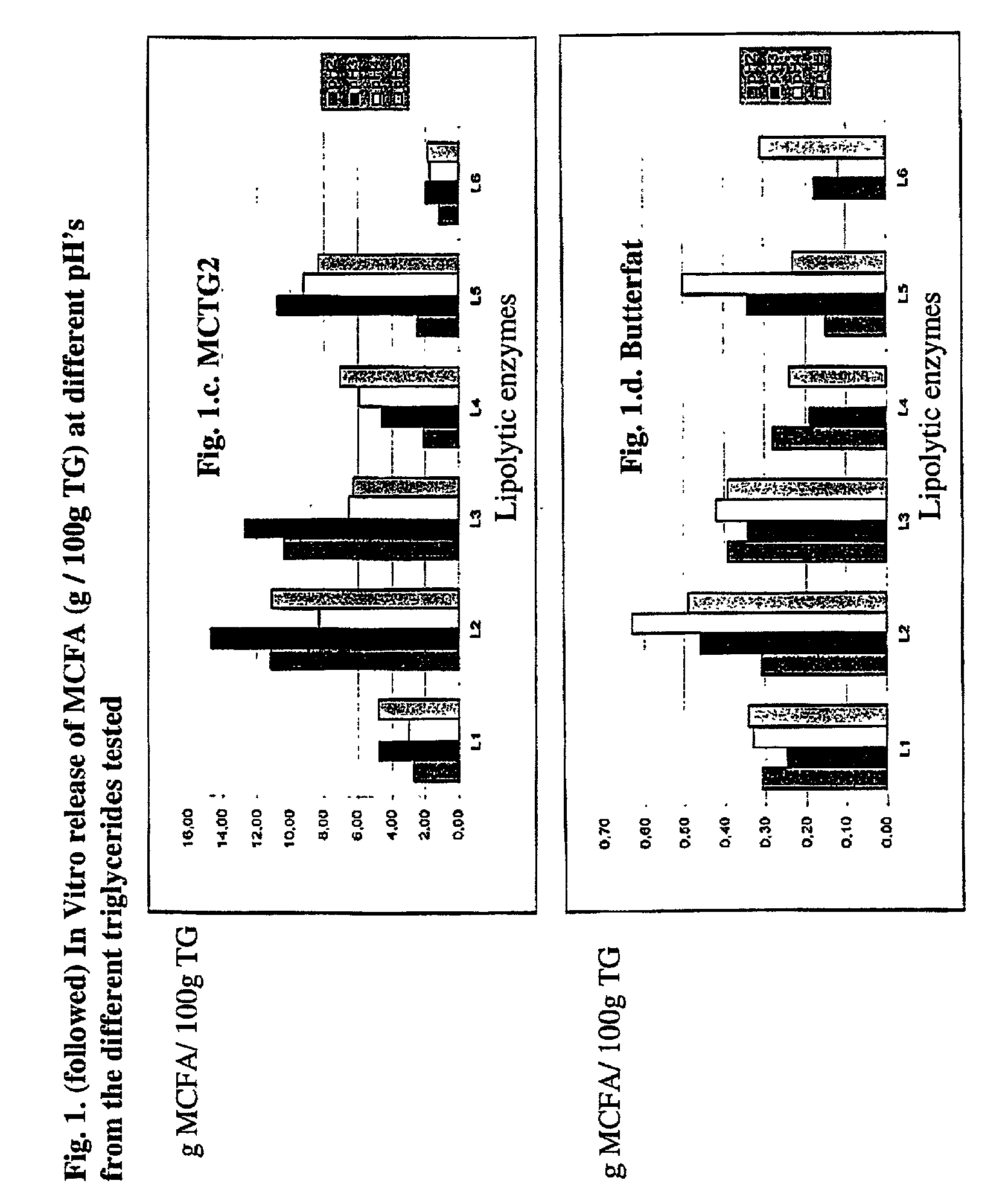Combined use of triglycerides containing medium chain fatty acids and exogenous lipolytic enzymes as feed supplements
a technology of exogenous lipolytic enzymes and triglycerides, which is applied in the field of combined use of triglycerides containing medium chain fatty acids and exogenous lipolytic enzymes as feed supplements, can solve the problems of affecting the growth of piglets, so as to improve the growth rate, stabilize the gastrointestinal microflora, and be easily digestible and metabol
- Summary
- Abstract
- Description
- Claims
- Application Information
AI Technical Summary
Benefits of technology
Problems solved by technology
Method used
Image
Examples
example 1
In Vitro Screening of MCFA Containing TG's and Lipolytic Enzymes for Lipolysis at Different pH's (Simulation of Gastric Conditions)
[0047]A selection of lipolytic enzymes to be tested, coded L1 to L6, was made which was based on their commercial availability and feasable price in commercial settings. MCFA containing TG's were selected on the basis of their specific MCFA content in the fat as specified in table 1.
[0048]
TABLE 1MCFA concentration (g / 100 g FA) in the selected TG'sC4C6C8C10C12Butterfat3.42.11.22.63.0Coconut oil00.78.56.248.8MCTG 102.869.127.70.4MCTG 200.257.542.30.0
[0049]The in vitro incubations were done in buffered circumstances at different pH's; a glycine buffer was used for incubations at pH 2 and pH 3; an acetate buffer was used for incubations at pH 4 and pH 5. Incubations were done for 180 min at 37° C. in a shaking water bath. The parameters used for the incubations were chosen in order to simulate as closely as possible the in vivo conditions in gastric contents...
example 2
In Vivo Experiment with Gastric Cannulated Pigs for the Study of the Release In Situ of MCFA by Endogenous and Exogenous Lipolytic Enzymes
[0051]Three pigs (Belgian Landrace, stress negative, female) with an initial weight of ±8.5 kg were prepared with a gastric cannula using the technique of DECUYPERE et al. (1977). The cannulae were placed midway the curvatura major in the fundic region.
[0052]Three TG's (coconut oil, MCTG1 and butterfat, each) and 2 lipases (L2 and L5) were selected for the present experiment
[0053]Nine feeds were prepared using 95% of a commercial feed for piglets with 5% of the selected (eventually molten) TG's all or not supplemented with the selected lipases (see Table 2 for the codes used further on). The fats were simply poured on the meal and thoroughly mixed in a horizontal mixer. The concentration of the lipases was 1000 ppm of the commercial preparation in the feed
[0054]
TABLE 2Feeds used in experiment 2Coconut oil:V1: 95% piglet feed + 5% coconut oilV2: id...
example 3
Zootechnical Experiment in Commercial Settings: Growth Performance Combined with Ex Vivo Observations on the Gastric Contents
[0075]The aim of this experiment was to check if the above mentioned concept was applicable and suitable in commercial settings and to check, when a growth promotion was obtained, this was comparable with the growth promotion obtained in early weaned piglets with antibiotics or a combination of organic acids with proven effectiveness.
[0076]For this experiment 244 freshly weaned piglets (Seghers Hybrid F1, initial w eight±6.5 kg) were divided according to litter, sex and weight in 4 groups: A: 68; B=61; C=60 and D=55 piglets. The experiment was run in commercial settings in temperature controlled facilities.
[0077]The composition of the feeds used was based on barley, wheat, maize flakes, extruded maize, extruded soybeans, soy-flour, herring meal, 2.5% TG, and a commercial premix (mainly based on milk products, vitamins+minerals) for early weaned piglets (12.5%)...
PUM
| Property | Measurement | Unit |
|---|---|---|
| Percent by mass | aaaaa | aaaaa |
| Fraction | aaaaa | aaaaa |
| Fraction | aaaaa | aaaaa |
Abstract
Description
Claims
Application Information
 Login to View More
Login to View More - R&D
- Intellectual Property
- Life Sciences
- Materials
- Tech Scout
- Unparalleled Data Quality
- Higher Quality Content
- 60% Fewer Hallucinations
Browse by: Latest US Patents, China's latest patents, Technical Efficacy Thesaurus, Application Domain, Technology Topic, Popular Technical Reports.
© 2025 PatSnap. All rights reserved.Legal|Privacy policy|Modern Slavery Act Transparency Statement|Sitemap|About US| Contact US: help@patsnap.com



